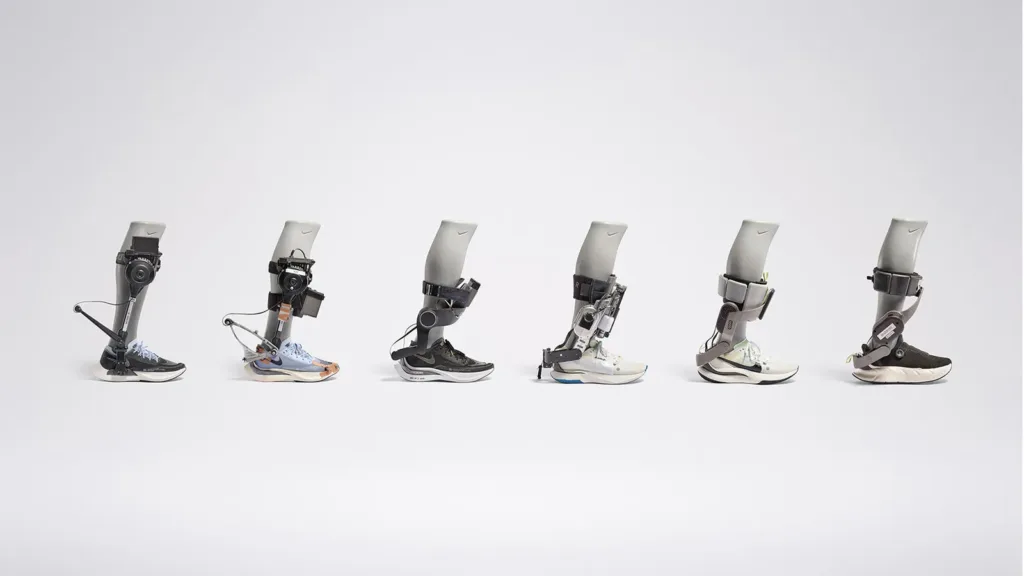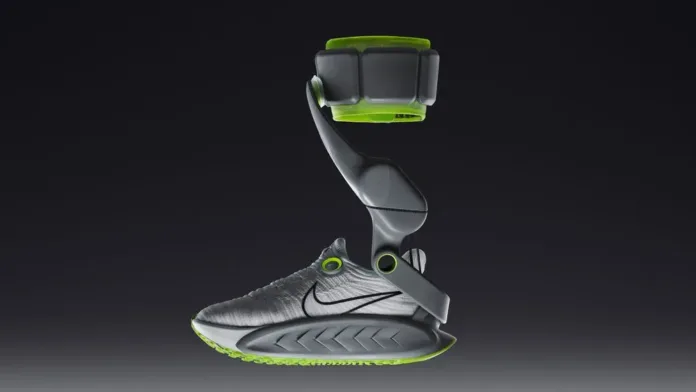Table of Contents
Nike has unveiled Project Amplify, a groundbreaking powered footwear system that changes the concept of shoes from passive gear to active movement enhancers. This innovation is set to reshape how everyday athletes experience walking, jogging, and running by providing mechanical assistance integrated into a running shoe. At Squaredtech, we analyze this exciting development, exploring the technology, strategic importance, and future prospects of Nike’s latest offering.

The Technology Behind Nike’s Powered Footwear System
Project Amplify is the result of collaboration between Nike and the robotics company Dephy. It combines a lightweight motor and a drive-belt mechanism integrated seamlessly into a carbon-plated running shoe. The system is powered by a rechargeable battery cuff worn at the ankle, which supplies energy to the motor, supporting natural leg and ankle movement.
This design strategically avoids bulk, ensuring that the shoe remains wearable even without activating the motorized assistance. The objective is clear—augment the natural mechanics of lower leg muscles to enhance movement efficiency. Nike frames this as giving athletes “a second set of calf muscles,” offering a physical boost during walking or running.
Internal testing at Nike involved over 400 athletes and accumulated more than 2.4 million steps, gathering extensive data on performance improvements. Some users noted a remarkable improvement in pace, reducing a 12-minute mile to just 10 minutes when using the footwear. This mechanical assistance translates to a tangible speed and endurance gain, not aimed at elite runners but designed for moderate pace athletes and daily movement.
Read more about our Article of From Clothes to Shoes: Google Expands Its Virtual Try-On Experience Globally, published on October 11th 2025, Squaredtech
A New Target Audience for Powered Footwear
Unlike previous athletic technological advances often designed to push elite performance, Project Amplify focuses explicitly on the “everyday athlete.” Nike’s inclusive philosophy—“If you have a body, you are an athlete”—extends into assisted movement, appealing to a broad range of users.
People who run or walk comfortably at a 10 to 12-minute mile pace or those looking to reduce physical strain will find this innovation appealing. The powered shoes provide assistance that can make previously challenging movements, such as uphill climbs, feel as easy as walking on flat terrain.
A reviewer described the sensation like having an “e-bike for your feet,” emphasizing that the boost makes movement more enjoyable and less physically taxing. For many, this could encourage increased physical activity by reducing barriers related to fatigue and discomfort. Squaredtech recognizes the significance of this shift—powered footwear moves beyond performance enhancement into accessibility and enjoyment of movement.
Nike’s Strategic Innovation Amid Market Challenges
Nike introduced Project Amplify at a time when it faces intensified market competition and pressure on its innovation leadership. Sales slowdowns and rivals’ advances have heightened industry scrutiny about our trusted brand’s pipeline for future technology.
Releasing an advanced, powered footwear system sends a strong message: Nike remains committed to leading in athletic innovation, merging robotics and footwear technology. Project Amplify is part of a broader strategy Nike calls its “innovation engine,” which also explores innovations like cooling apparel, neuroscience-driven footwear, and advanced knit materials.
These simultaneous efforts signal Nike’s intent to redefine athletic movement and consumer experience beyond aesthetic or branding appeal. At Squaredtech, we see this as clear evidence of Nike’s ambition not just to keep pace but to set the pace in the future of sports technology.
Challenges and Considerations for Project Amplify’s Future
Despite its promise, Project Amplify faces several challenges before becoming widely available. Nike admits the technology remains early in development and a consumer launch is still years away. Practical concerns about battery life, weight, durability, production cost, and user experience are central to moving from prototypes to everyday products.
Feedback from early testers revealed a learning curve and an initial sense that the powered shoes are not yet a perfectly smooth experience. Consumer adoption will depend on addressing these issues alongside aesthetic design, so the powered footwear looks and feels like natural athletic gear rather than a cumbersome device.
Market positioning also raises questions. Will this technology appeal mainly to fitness enthusiasts seeking enhanced performance, or will it serve people with mobility challenges who may benefit from assistance? Nike’s current messaging promotes broad inclusion, but business models and pricing strategies will have to clarify target demographics.
Why Nike’s Project Amplify Matters for Movement and Technology
Project Amplify reflects a significant shift in sports equipment—from passive accessories like shoes and apparel to active systems that directly support human motion. Nike’s claim that the project “breaks the perception of possibility” signals a new era where wearable robotics could become an everyday part of how people move.
The potential impacts extend beyond sport. Imagine a world where daily walking commutes feel effortless, hiking routes with steep inclines feel manageable, and jogs become more enjoyable. This conceptual leap transforms footwear from mere gear to a partner in movement, enhancing accessibility, fun, and longevity.
For many consumers, this means improved quality of life by making physical activity less tiring and more achievable. Squaredtech views this as a pioneering step toward integrating robotics with personal fitness and mobility aids, blending technology and human movement in practical, meaningful ways.
Looking Ahead: The Road to Market and Broader Adoption
Nike has developed over nine different prototypes and conducted extensive testing to refine Project Amplify’s hardware, software, and overall user experience. However, the company has not set a public release date or price point, only indicating that commercial availability is years away.
Success depends on several factors: improving the mechanics to be seamless, balancing weight and power, perfecting design, and ensuring the shoes attract a broad user base. If Nike achieves these goals, powered footwear could become as common as traditional running shoes, combining advanced robotics with athletic wear.
For Squaredtech and the broader industry, Project Amplify embodies future possibilities: where technology supports and expands human capabilities, changing not only how we exercise but how we live. As Nike pioneers this path, the next generation of footwear might offer more than style and comfort—it could offer a motorized boost with every step.
Stay Updated: GADGETS – Artificial Intelligence


